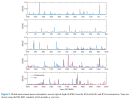I have recently been looking at the paper Climate variability and change since 850 CE (Climate Variability and Change since 850 CE: An Ensemble Approach with the Community Earth System Model) and the corresponding data sets that go with it at www2.cesm.ucar.edu/models/experiments/LME.
What I would like to grab from the data set are aerosol optical depth values from the volcano forcing runs, but I wonder if what I found is the correct one, or if this is included in the data set at all.
I have been looking at the variable fields AODVIS and AODABS, specifically the file (found here)
b.e11.BLMTRC5CN.f19_g16.VOLC_GRA.001.cam.h0.AODVIS.085001-184912.nc
and the corresponding files for the five ensemble members. Are these files and variable fields are the correct ones to use for looking at aerosol optical depth in CESM LME? (The attached file showing "CL AOD" is CESM LME AODVIS ensemble median.)
The reason I am asking is because, when I look at the time series both AODVIS and AODABS have very small perturbations. The perturbations due to volcanoes are easily seen, but they are and order of magnitude smaller than what is used for example in the attached Figure5 (from Toohey and Sigl (2017), ESSD - Volcanic stratospheric sulfur injections and aerosol optical depth from 500 BCE to 1900 CE). Also attached is a plot of the ensemble median of the AODVIS that I obtained from the file mentioned above.


What I would like to grab from the data set are aerosol optical depth values from the volcano forcing runs, but I wonder if what I found is the correct one, or if this is included in the data set at all.
I have been looking at the variable fields AODVIS and AODABS, specifically the file (found here)
b.e11.BLMTRC5CN.f19_g16.VOLC_GRA.001.cam.h0.AODVIS.085001-184912.nc
and the corresponding files for the five ensemble members. Are these files and variable fields are the correct ones to use for looking at aerosol optical depth in CESM LME? (The attached file showing "CL AOD" is CESM LME AODVIS ensemble median.)
The reason I am asking is because, when I look at the time series both AODVIS and AODABS have very small perturbations. The perturbations due to volcanoes are easily seen, but they are and order of magnitude smaller than what is used for example in the attached Figure5 (from Toohey and Sigl (2017), ESSD - Volcanic stratospheric sulfur injections and aerosol optical depth from 500 BCE to 1900 CE). Also attached is a plot of the ensemble median of the AODVIS that I obtained from the file mentioned above.


